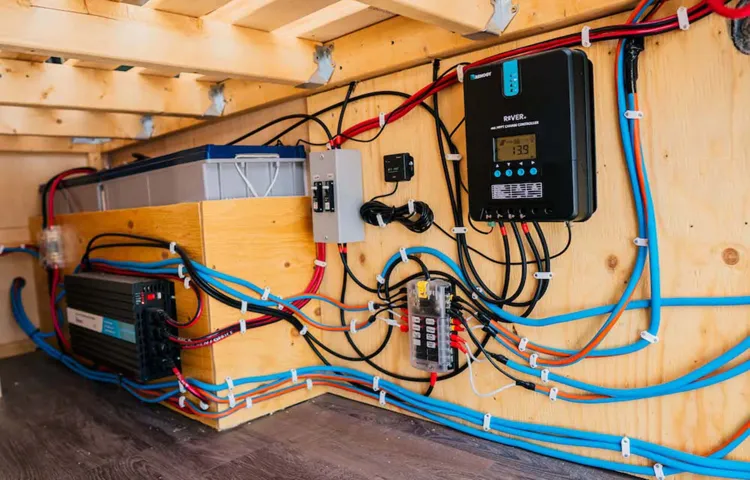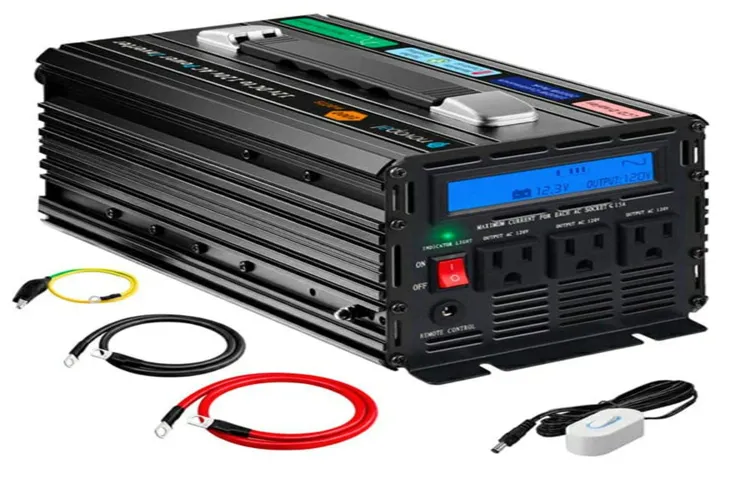Have you ever been on a camper trip and suddenly realized you needed to power your appliances, but couldn’t find the power inverter? It can be frustrating and leave you feeling like you’re in the dark. But fear not! In this blog post, we’ll show you exactly where to find the power inverter in your camper, so you can keep your devices charged and enjoy all the comforts of home on the road. Think of the power inverter as the engine that converts the camper’s DC power (from the batteries) into AC power (the kind you use to power your appliances).
It’s like the beating heart of your camper’s electrical system, delivering the power you need to operate your lights, fans, and other essential devices. So where can you find this essential component? Well, the location may vary depending on the make and model of your camper, but there are a few common places to check. One of the most common spots to find the power inverter is in the storage compartments of your camper.
These compartments are usually located on the outside near the batteries, and they often house the electrical components of the camper. Look for a metal box or a plastic housing with wires connected to it. This is likely where your power inverter is hiding.
Another place to look is under the bed or sofa in your camper. Many campers have hidden compartments in these areas, which are perfect for concealing the power inverter. Take a peek under the cushions or pull up the mattress to see if you can spot it.
If you still can’t find the power inverter, it’s worth checking the owner’s manual or contacting the manufacturer for specific instructions. Each camper is unique, and the power inverter could be tucked away in a less obvious location. Now that you know where to look, you can easily locate the power inverter in your camper and ensure you always have the power you need while on your adventures.
No more fumbling around in the dark – you’ll be powered up and ready to go! So go ahead, pack your bags, hit the road, and enjoy the comforts of home wherever you roam.
Table of Contents
Introduction
If you’re wondering where the power inverter is located on a camper, you’re not alone! The power inverter is an essential component of a camper’s electrical system, as it is responsible for converting direct current (DC) power from the batteries into alternating current (AC) power that can be used to operate appliances and charge devices. In most campers, the power inverter is usually located near the batteries or the electrical distribution panel. However, the specific location can vary depending on the make and model of the camper.
It’s always a good idea to consult the owner’s manual or contact the manufacturer for precise information on the location of the power inverter in your camper. After all, being able to easily access and maintain the power inverter is crucial for troubleshooting electrical issues and ensuring a smooth camping experience. So, take a moment to familiarize yourself with the location of the power inverter in your camper, and you’ll be better prepared for any electrical needs on the road!
Understanding the Power Inverter
power inverter, understanding, introduction

Locating the Power Inverter
So you’re on a camping trip and suddenly you need to find the power inverter on your camper. Don’t worry, I’ve got you covered! The power inverter is like the magical creature that turns the DC power from your camper’s battery into AC power that you can use to charge your gadgets or power appliances. It’s usually located near the electrical panel or the battery compartment.
You might need to dig around a little bit, but it’s usually easy to spot because it’s a box-shaped device with wires coming in and out of it. It might even have some labels or indicators to help you identify it. So next time you find yourself wondering “where is the power inverter on my camper?” just follow the wires and keep an eye out for that box-shaped beauty.
Happy camping!
Checking the Manufacturer’s Manual
“power inverter” The power inverter is a vital component in many electronic devices, allowing them to run on DC power from a battery or solar panel. To locate the power inverter in your device, the first step is to consult the manufacturer’s manual. This manual provides detailed instructions and diagrams to help you navigate through the device’s internal components.
Look for the section that specifically addresses the power inverter or inverter board. It may also be referred to as the inverter module. Once you have located the section in the manual, it will guide you on how to access the power inverter safely.
Keep in mind that some devices may have the power inverter located in a hard-to-reach or tightly sealed compartment, so following the manufacturer’s instructions is essential. By checking the manufacturer’s manual, you can ensure that you are properly locating and accessing the power inverter, troubleshoot any issues, and make any necessary repairs or replacements.
Inspecting the Storage Compartments
When inspecting the storage compartments of your vehicle, one important component to locate is the power inverter. This handy device allows you to convert the 12-volt direct current (DC) power from your car’s battery into 120-volt alternating current (AC) power, which can be used to power various electronic devices. So, whether you’re on a road trip and need to charge your laptop or camping and want to power a small refrigerator, the power inverter can come in handy.
It’s like having a portable electrical outlet in your car! So, the next time you’re exploring the storage compartments of your vehicle, keep an eye out for the power inverter and harness the power of AC electricity on the go.
Examining the Electrical Panel
power inverter, electrical panel
Identifying Signs of the Power Inverter
If you’re wondering where the power inverter is on your camper, you’re not alone. Many campers are equipped with power inverters, which are responsible for converting the electricity from the battery into a usable form for appliances and devices. Typically, the power inverter is located in the same area as the battery, which is often in a compartment on the outside of the camper.
It may be secured with brackets or mounted to a wall. However, the exact location can vary depending on the make and model of your camper. To locate the power inverter, you can start by checking the battery compartment or any nearby storage compartments.
Look for a rectangular box with wires connected to it, as that is likely the power inverter. If you’re still having trouble finding it, consult your camper’s owner’s manual or reach out to the manufacturer for assistance. Happy camping!
Checking for Wiring
power inverter
Looking for Voltage Displays
voltage displays, power inverter, identifying signs
Conclusion
So, where is the power inverter on a camper, you ask? Well, my friend, the power inverter is a cunning master of disguise, like a chameleon blending into its surroundings. It is a mythical creature that seamlessly integrates itself into the heart of the camper, hidden away from prying eyes. Much like the elusive Sasquatch, the power inverter can be a challenge to locate.
It might be lurking beneath the kitchen counter, stealthily powering your blender while you whip up a batch of margaritas. Or perhaps it has taken up residence behind the sofa, quietly running your entertainment system as you binge-watch your favorite shows. But fear not, intrepid adventurer, for with a keen eye and a bit of perseverance, you shall uncover its hiding place.
It may be nestled within a cabinet, disguised as a harmless storage compartment. Or it might be concealed within the depths of a storage locker, waiting patiently to unleash its electrically charged powers. And when you finally do find the power inverter, bask in the triumph of your discovery.
For you have unlocked the secret to unlimited power on your camper, harnessing electricity like a wizard wielding a magical staff. You can now charge your devices, make your coffee, and keep your refrigerator humming with ease. So, my curious comrade, take up the challenge, embark on the quest, and unveil the location of the power inverter on your camper.
And remember, with great power comes great responsibility…and the occasional need to juice up your smartphone.”
FAQs
Where is the power inverter located on a camper?
The power inverter is typically located near the electrical control panel or battery compartment of a camper.
Can I install a power inverter in a camper myself?
Yes, you can install a power inverter in a camper yourself, but it is recommended to consult the manufacturer’s guidelines or seek professional assistance to ensure proper installation and safety.
What size power inverter do I need for a camper?
The size of the power inverter you need for a camper depends on the electrical appliances you plan to use. It is recommended to calculate the total wattage of all the appliances and choose an inverter that can handle that capacity.
Can a power inverter run all appliances in a camper?
The capacity of a power inverter varies, and not all inverters can handle all appliances in a camper. It is important to check the wattage requirements of each appliance and choose an inverter that can handle the total load.
How does a power inverter work in a camper?
A power inverter converts the 12-volt DC power from the camper’s batteries into 120-volt AC power, allowing you to use regular household appliances and electronics on board.
Can a power inverter drain the camper’s batteries quickly?
Yes, a power inverter can drain the camper’s batteries if left running for an extended period without a power source. It is important to monitor the battery levels and turn off the inverter when not in use.
How can I troubleshoot a power inverter issue in my camper?
If you experience issues with your power inverter, first check the connections, fuses, and switches. Also, make sure the batteries are charged and in good condition. If the problem persists, consult a professional for further diagnosis and repair.


